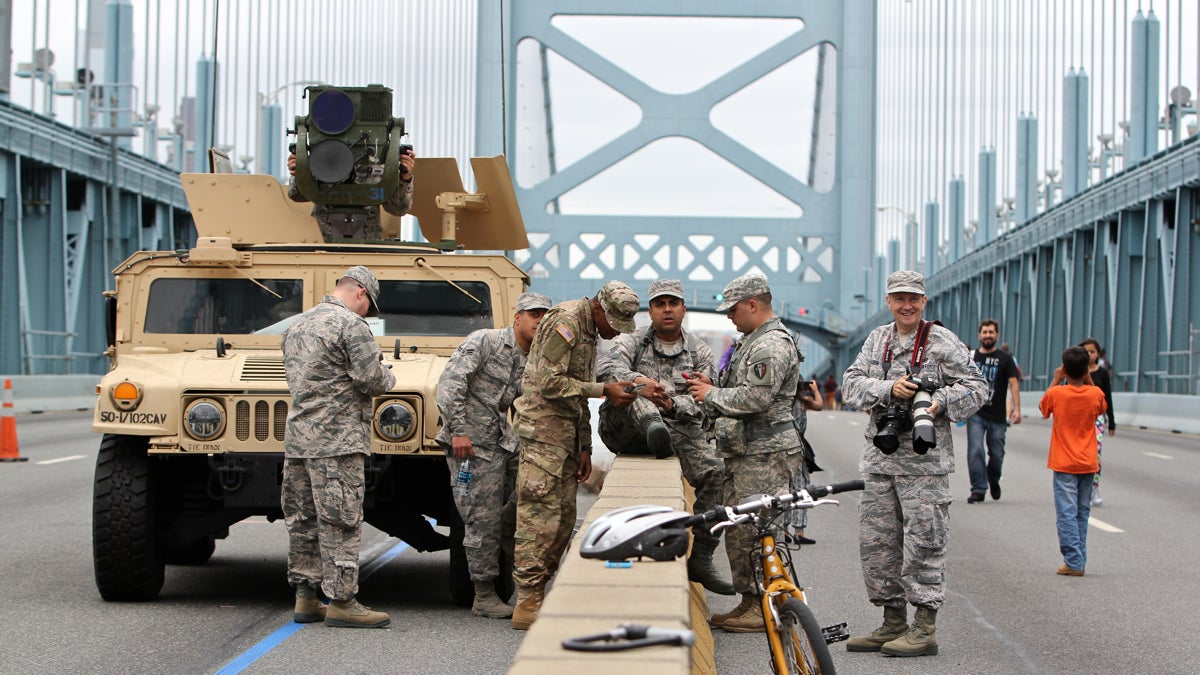Visitors assess Philly’s papal security: ‘Nightmare’ to ‘chaos’ to ‘not a big deal’
Listen
Members of the National Guard stand watch on the Ben Franklin Bridge during the papal visit (Emma Lee/WHYY)
When the leader of the global Roman Catholic Church plans a trip, a heavy security blanket is expected.
But did Philadelphia’s clampdown go too far for Pope Francis’ visit? There were grumblings as the papal visit approached about traffic restrictions and road closures — gripes that would only amplify as a vast security infrastructure bore down across a wide swath of Center City.
The frustrations perhaps peaked as thousands of pilgrims attempted to wade through a city riddled with checkpoints and barricades over the weekend.
Just ask Miguel Marquez, a reporter for CNN, who was staring down a thick hours-long line of people waiting to get through a security checkpoint to hear the pope celebrate Sunday Mass on the Benjamin Franklin Parkway.
“It is a nightmare, a security nightmare,” Marquez said. “I’ve worked in Iraq, I’ve worked in Afghanistan, I’ve worked in the military all over the world. I’ve never seen anything quite like this. Getting into the Green Zone was easier than getting into this location.”
Marquez isn’t the only one who viewed the lockdown of Center City, TSA security pat-downs and rows of steel fences as, at best, disturbing optics, and at worst, complete overkill.
“It didn’t have to be this intense. I mean, it’s way over the top,” said Dick Rainer from Delaware County. “I thought I was in the ‘Twilight Zone.'”
The labyrinth of security was an unsettling introduction to Philadelphia for Stephanie Hand-Cannane of Ohio.
“This is chaos,” Hand-Cannane said. “I would like to come back when there are no events. When it’s just the regular town.”
Huge area to secure
More than 70 law enforcement agencies collaborated in coming up with the security planning. It took more than 20 subcommittees and lots of negotiating over many months, said Robert Hoback, a Secret Service spokesman.
It was different from the pope’s visits in New York and Washington, officials said, because his travels covered so much of Center City and also included a giant outdoor Mass.
The largest national special security event since the late 1990s, Hoback said, when the procedures for these types of events were established to deal with big gatherings that could be targeted by terrorists. They include State of the Union addresses, U.N. General Assembly meetings, even Super Bowls.
“I don’t know that there was an over-response,” he said. “I think you have to look at the venue.”
The Department of Homeland Security had no credible threats against the pope, but still couldn’t afford to leave anything to chance, Hoback said.
“The events in Philadelphia stretched from the Art Museum, all the way down to City Hall and then over to Independence Mall, that’s why you saw the security apparatus that you saw in Philadelphia,” he said. “It may be why folks had the perception that it’s different than New York and D.C.”
While some likened the security to a creepy police state, others found the presence of hundreds of armed officers and maze of security reassuring.
Sameer Patel, a plastic surgeon, said he had no worries.
“If you asked most of the people who are here enjoying this day, this beautiful day, waiting for this Mass to start, they would say, ‘Hey, look, I feel safe, I feel secure,'” Patel said. “And whether they blocked of a few more streets than they had to or not, at the end of the day, it’s not a big deal.”
Lockdown yields some unusual mobility
In Chinatown, away from the pulsing excitement, Fatima Morales didn’t look bothered. She was leisurely pedaling around on her bike on a car-less street. The massive security lockdown provided many with a new, open view of Philadelphia, an almost carless oasis. Morales relished the moment, “then I crossed with another girl who was also biking, and I think we had the same feeling,” she said.
“We looked at each other and just smiled and said, ‘OK, we have to enjoy this. It’s nice,'” Morales said.
The experience has led to an online petition, calling on the city to make reclaiming public streets a tradition.
To be sure, fewer are hoping to relive the feeling of being surrounded by steel fences as armored choppers spin around in the sky.
“There was no zipping. At all,” said Marquez, describing what it was like getting from point to point. “It was a long, hard slog.”
WHYY is your source for fact-based, in-depth journalism and information. As a nonprofit organization, we rely on financial support from readers like you. Please give today.

